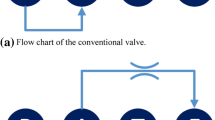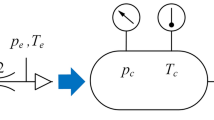Abstract
Operating point drift over large temperature spans can significantly degrade the performance of servo valves. The direction and magnitude of the deviation of the operating point are uncertain. To analyze and evaluate the mechanism of this complex system with a multi-level structure and multi-variables, it is necessary to construct a theoretical model with a clear physical concept to describe it. However, since the physical processes contain complex variations of structural parameters and flow properties, there is a problem of simplifying approximations in deriving analytical mathematical relations. The advantages of multi-physics field numerical analysis can compensate for this shortcoming of analytical formulations. Based on this, we constructed a whole-valve transfer function model to realize the mechanism analysis and evaluate the operating point drift when a thermal effect acts on a servo valve. The results show that the asymmetric fit relationship between the armature-nozzle assemblies is an important reason for the drift of the operating point caused by the thermal effect. Differences in structural parameters and fluid medium characteristics at different temperatures lead to nonlinear changes in the operating point. When the deviation angle reaches ±1°, an increase in temperature will cause the absolute value of the tangent slope of the displacement deviation of the spool to decrease from 1.44×10−5 m/°C to 1.25×10−6 m/°C. The influence of the deviation angle is reflected in the change in the absolute value of the tangent slope of the pressure deviation from 1. 14×103 Pa/°C to 110 Pa/°C.
概要
目的:大温度范围内的工作点漂移会显著降低伺服阀的性能,但工作点偏差的方向和幅度具有不确定性。本文旨在建立一个清晰的理论模型物理概念来描述、分析和评估这个具有多层次结构和多变量机制的复杂系统。 创新点:由于物理过程包含结构参数和流动特性的复杂变化,因此在推导解析数学关系时存在简化近似的问题。本文采用的多物理场数值分析的优点可以弥补分析公式的这一缺点。 方法:在建立理论模型和进行数值分析的基础上,构建全阀传递函数模型,实现热效应作用于伺服阀时的机理分析和工作点漂移评估。 结论:1. 衔铁-喷嘴组件之间的不对称配合关系是热效应引起工作点漂移的重要原因。2. 不同温度下结构参数和流体介质特性的差异可导致工作点非线性变化。3. 当偏差角达到±1°时,温度升高会导致阀芯位移偏差的切线斜率绝对值从1.44×10−5减小到1.25×10−6 m/°C;偏差角的影响体现在压力偏差的切线斜率绝对值从1. 14×103 Pa/°C到110 Pa/°C的变化。
Similar content being viewed by others
References
Aung NZ, Li SJ, 2014. A numerical study of cavitation phenomenon in a flapper-nozzle pilot stage of an electrohydraulic servo-valve with an innovative flapper shape. Energy Conversion and Management, 77:31–39. https://doi.org/10.1016/j.enconman.2013.09.009
Aung NZ, Yang QJ, Chen M, et al., 2014. CFD analysis of flow forces and energy loss characteristics in a flapper-nozzle pilot valve with different null clearances. Energy Conversion and Management, 83:284–295. https://doi.org/10.1016/j.enconman.2014.03.076
Chen ZQ, Wang WH, 2018. Analysis of temperature characteristics of electro-hydraulic servo valve based on AMESim. International Conference on Mechanical, Electrical, Electronic Engineering and Science, p.47–53. https://doi.org/10.2991/meees-18.2018.10
Jacob, Mchenya M, Zhang SZ, et al., 2011. A study of flow-field distribution between the flapper and nozzle in a hydraulic servo-valve. Proceedings of the International Conference on Fluid Power and Mechatronics, p.658–662. https://doi.org/10.1109/FPM.2011.6045844
Kim DH, Tsao TC, 2000. A linearized electrohydraulic servo-valve model for valve dynamics sensitivity analysis and control system design. Journal of Dynamic Systems, Measurement, and Control, 122(1):179–187. https://doi.org/10.1115/1.482440
Li L, Li CC, Yan H, et al., 2017. Research on temperature drift current fluctuation of nozzle flapper servo valve. Journal of Beijing Jiaotong University, 41(3):96–102. https://doi.org/10.11860/j.issn.1673-0291.2017.03.015
Li L, Yan H, Zhang HX, et al., 2018. Numerical simulation and experimental research of the flow force and forced vibration in the nozzle-flapper valve. Mechanical Systems and Signal Processing, 99:550–566. https://doi.org/10.1016/j.ymssp.2017.06.024
Li SJ, Aung NZ, Zhang SZ, et al., 2013. Experimental and numerical investigation of cavitation phenomenon in flapper-nozzle pilot stage of an electrohydraulic servo-valve. Computers & Fluids, 88:590–598. https://doi.org/10.1016/j.compfluid.2013.10.016
Li YS, 2016. Mathematical modelling and characteristics of the pilot valve applied to a jet-pipe/deflector-jet servo-valve. Sensors and Actuators A: Physical, 245:150–159. https://doi.org/10.1016/j.sna.2016.04.048
Liu CH, Jiang HZ, 2014. A seventh-order model for dynamic response of an electro-hydraulic servo valve. Chinese Journal of Aeronautics, 27(6):1605–1611. https://doi.org/10.1016/j.cja.2014.10.029
Mchenya JM, Zhang SZ, Li SJ, 2011. Visualization of flow-field between the flapper and nozzle in a hydraulic servo-valve. Advanced Materials Research, 402:407–411. https://doi.org/10.4028/www.scientific.net/AMR.402.407
Merritt HE, 1967. Hydraulic Control Systems. John Wiley and Sons, New York, USA, p.47–65. https://doi.org/10.1115/1.3601167
Merritt HE, 1968. Hydraulic control systems. Journal of Applied Mechanics, 35(1):200. https://doi.org/10.1115/1.3601167
Mu DJ, Li CC, 2011. A new mathematical model of twin flapper-nozzle servo valve based on input-output linearization approach. Proceedings of the 2nd International Conference on Artificial Intelligence, Management Science and Electronic Commerce, p.3662–3666. https://doi.org/10.1109/AIMSEC.2011.6009893
Pan XD, Wang GL, Lu ZS, 2011. Flow field simulation and a flow model of servo-valve spool valve orifice. Energy Conversion and Management, 52(10):3249–3256. https://doi.org/10.1016/j.enconman.2011.05.010
Pountney DC, Weston W, Banieghbal MR, 1989. A numerical study of turbulent flow characteristics of servo-valve orifices. Proceedings of the Institution of Mechanical Engineers, Part A: Journal of Power Engineering, 203(2):139–147. https://doi.org/10.1243/pime_proc_1989_203_018_02
Somashekhar SH, Singaperumal M, Kumar RK, 2007. Mathematical modelling and simulation of a jet pipe electrohydraulic flow control servo valve. Proceedings of the Institution of Mechanical Engineers, Part I: Journal of Systems and Control Engineering, 221(3):365–382. https://doi.org/10.1243/09596518jsce238
Urata E, 2000. Study of magnetic circuits for servovalve torque motors. Proceeding of the Bath Workshop on Power Transmission and Control, p.269–282.
Yan H, Ren YK, Yao L, et al., 2019. Analysis of the internal characteristics of a de Ector Jet servo valve. Chinese Journal of Mechanical Engineering, 32(2):180–192.
Yan L, Zhang QF, Duan ZH, et al., 2017. Modeling and analysis of servo valve torque motor based on FEM. Proceedings of the IEEE International Conference on Cybernetics and Intelligent Systems and the IEEE Conference on Robotics, Automation and Mechatronics, p.791–796. https://doi.org/10.1109/ICCIS.2017.8274880
Yang H, Wang W, Lu KQ, 2019. Numerical simulations on flow characteristics of a nozzle-flapper servo valve with diamond nozzles. IEEE Access, 7:28001–28010. https://doi.org/10.1109/ACCESS.2019.2896702
Yu J, Zhuang J, Yu DH, 2014. Modeling and analysis of a rotary direct drive servovalve. Chinese Journal of Mechanical Engineering, 27(5):1064–1074. https://doi.org/10.3901/CJME.2014.0725.127
Zhang QF, Yan L, Duan ZH, et al., 2020. High torque density torque motor with hybrid magnetization pole arrays for jet pipe servo valve. IEEE Transactions on Industrial Electronics, 67(3):2133–2142. https://doi.org/10.1109/TIE.2019.2903761
Zhang X, Yin YB, Huang WD, 2010. Influence of temperature on null position pressure characteristics of flapper-nozzle servo valve. Proceedings of the International Conference on Computer Design and Applications, p.V3-257-V3-261. https://doi.org/10.1109/ICCDA.2010.5540780
Zhang Y, Wang SP, Shi J, et al., 2020. Evaluation of thermal effects on temperature-sensitive operating force of flow servo valve for fuel metering unit. Chinese Journal of Aeronautics, 33(6):1812–1823. https://doi.org/10.1016/j.cja.2019.09.011
Zhao JH, Zhou SL, Lu XH, et al., 2015. Numerical simulation and experimental study of heat-fluid-solid coupling of double flapper-nozzle servo valve. Chinese Journal of Mechanical Engineering, 28(5):1030–1038. https://doi.org/10.3901/cjme.2015.0417.045
Acknowledgments
This work is supported by the Civil Aircraft Research Project (No. MJ-2016-S-54), China.
Author information
Authors and Affiliations
Contributions
Jian KANG designed the research and wrote the first draft of the manuscript. Jing-chao LI processed the corresponding data and helped to organize the manuscript. Zhao-hui YUAN revised and edited the final version.
Corresponding author
Additional information
Conflict of interest
Jian KANG, Zhao-hui YUAN, and Jing-chao LI declare that they have no conflict of interest.
Rights and permissions
About this article
Cite this article
Kang, J., Yuan, Zh. & Li, Jc. Mechanism analysis and evaluation of thermal effects on the operating point drift of servo valves. J. Zhejiang Univ. Sci. A 23, 286–302 (2022). https://doi.org/10.1631/jzus.A2100464
Received:
Accepted:
Published:
Issue Date:
DOI: https://doi.org/10.1631/jzus.A2100464




